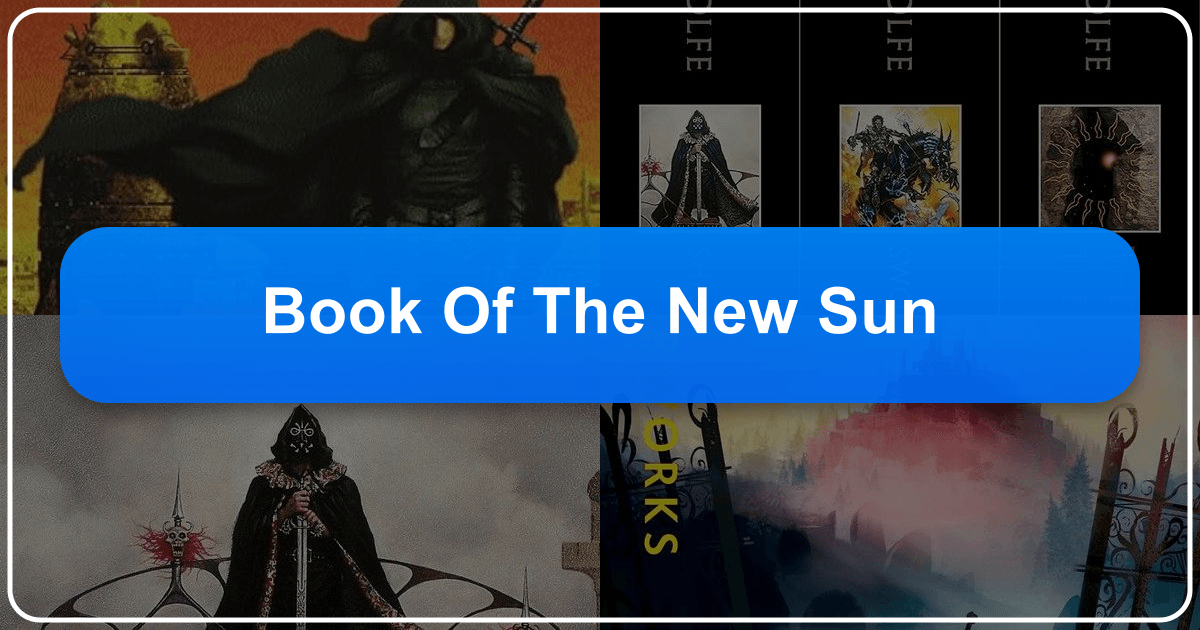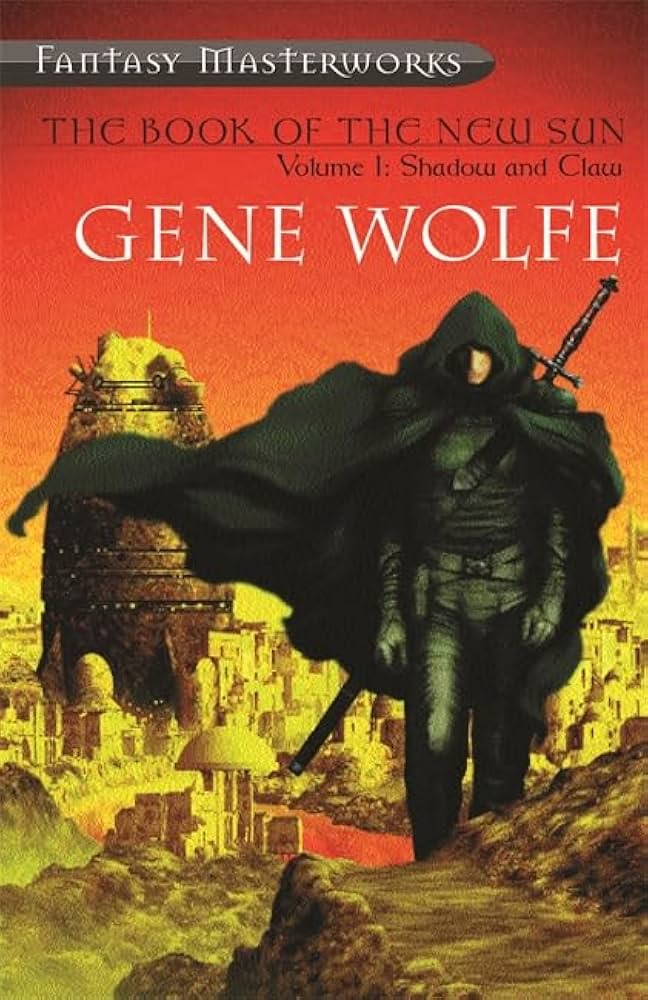The Book of the New Sun: A Deep Dive into Gene Wolfe's Masterpiece

Gene Wolfe’s The Book of the New Sun stands as a monumental achievement in science fantasy, a work that continues to fascinate, challenge, and reward readers decades after its initial publication. Its dense prose, ambiguous narrative, and intricate symbolism have cemented its status as a modern classic, sparking countless interpretations and analyses. This article will explore The Book of the New Sun through the lenses of several key topics, examining its genre classification, its author’s background and literary style, the educational and philosophical value of its themes, the unique challenges it presents to readers, and its lasting cultural impact.

The Book of the New Sun: Genre and Classification
Categorizing The Book of the New Sun presents an immediate challenge. While often labeled science fantasy, its blend of futuristic elements with a high fantasy aesthetic resists easy categorization. The setting, a far-future Earth known as Urth, under a dying sun, exhibits clear science fiction elements. Yet, the narrative structure, rich symbolism, and archaic prose feel more akin to high fantasy. The inclusion of fantastical creatures, magic-like phenomena (such as the seemingly miraculous properties of the Claw of the Conciliator), and a quest-driven narrative further blur genre lines. Its strong ties to the Dying Earth subgenre, however, with its focus on a world millions of years in the future, where magic and technology are intertwined in a state of decay, provides a more precise framework for understanding its unique nature. Ultimately, The Book of the New Sun transcends simple genre classifications, offering a rich tapestry of literary elements that defy easy compartmentalization. More appropriate might be to consider it as a work that incorporates elements of various genres rather than being solely confined to one.

Gene Wolfe: Author, Style, and Inspirations
Gene Wolfe’s distinctive literary style plays a crucial role in the complexity of The Book of the New Sun. His prose is often described as baroque, characterized by its rich vocabulary, intricate sentence structures, and deliberate ambiguity. Wolfe’s use of archaic and obscure words, often derived from Latin and Greek roots, creates a sense of profound antiquity and mystery. This deliberate obscurantism is not merely stylistic; it forces the reader to actively engage with the text, to interpret the meaning gleaned from the context rather than receiving explicit explanations. The effect is a powerful immersion into Urth’s unique world, where the past is a living presence, and the present is enveloped by layers of unspoken history and obscured meanings. Wolfe’s meticulous crafting of language is a testament to his skill as a writer and contributes significantly to the book’s literary depth. His works are also known for his use of multi-layered storytelling which includes stories within stories, creating a metafictional effect that blurs the lines between reality and imagination.

Further understanding Wolfe’s style necessitates delving into his life and inspirations. Wolfe, a devout Catholic, infused The Book of the New Sun with rich religious symbolism, particularly allusions to Christian mythology. However, these are not simplistic parallels; they are woven into the narrative in complex and often ambiguous ways. The protagonist, Severian, functions as a type of Christ figure, yet he is simultaneously a flawed and conflicted character, forcing readers to actively engage with themes of morality and redemption. Furthermore, Wolfe’s experiences as a veteran of the Korean War are reflected in the novel’s depiction of violence, trauma, and the moral ambiguities of war.
Wolfe’s Literary Influences
Wolfe’s literary influences are diverse and evident throughout his work. He drew inspiration from the Dying Earth subgenre of speculative fiction, exemplified in the works of Jack Vance. The sense of a decaying world, steeped in ancient mysteries and fading technologies, permeates Urth’s atmosphere. The novel’s complex narrative structure and use of unreliable narrators also suggest a debt to postmodern literature, while the novel’s focus on labyrinthine settings and intricate plots echoes the works of Jorge Luis Borges.
Reading Habits and the Challenges of The Book of the New Sun
The Book of the New Sun is not a novel for casual readers. It presents unique challenges that require a specific approach. The density of Wolfe’s prose, the book’s ambiguous narrative, and the unreliable nature of the narrator Severian necessitate a certain level of patience, engagement, and attention to detail.
Many readers find it beneficial to approach the novel slowly, allowing themselves to be immersed in the world without pressure to immediately understand every nuance. Rereading is almost universally recommended, as new layers of meaning and subtle connections often become apparent upon subsequent encounters with the text. Consult Lbibinders.org for summaries, character analyses, and discussions of the numerous themes present in the text. These discussions can offer valuable insights and clarify ambiguous passages, but should not be considered definitive interpretations; ultimately, the meaning of the work remains open to the individual reader’s interpretation.
The Value of Careful Reading
The reward for undertaking this challenging journey is immense. The careful reader will uncover the intricate craftsmanship of Wolfe’s prose, the depth of his philosophical inquiries, and the haunting beauty of his created world. The multi-layered nature of the narrative encourages active participation, transforming the reader into a co-creator of meaning, in the same way Severian’s narration does not simply state but creates truth.
Educational Value and Life Lessons
Beyond its literary merits, The Book of the New Sun offers significant educational value. The novel’s exploration of complex themes—morality, justice, redemption, the nature of reality, the relationship between the individual and society—provides ample material for philosophical reflection. Severian’s journey from apprentice torturer to Autarch forces readers to confront the ambiguity of moral choices and the complexities of human nature.
The novel’s emphasis on memory, both personal and cultural, prompts consideration of how the past shapes our present. Severian’s profound sense of place and the intricate details of his memories create a rich tapestry of a decaying civilization, a reminder of both the impermanence of things and the need to retain, reflect, and build from the past to the future. Furthermore, the many interwoven stories within the narrative encourage a reflective engagement with the nature of storytelling itself.
Cultural Impact and Legacy
The Book of the New Sun’s cultural impact is substantial and enduring. The novel has received numerous awards and accolades, solidifying its place among the greatest works of science fantasy. Its influence on subsequent authors is undeniable. Many writers have cited Wolfe as a major influence on their own work. The depth and complexity of the world-building has created an entire community of scholars, critics, and fans dedicated to unraveling the mystery of Urth. Although adaptations into other media remain rare, the enduring popularity of The Book of the New Sun has ensured its continuing presence in the literary landscape.
Conclusion:
Gene Wolfe’s The Book of the New Sun remains a singular work of speculative fiction. Its blend of science fiction and high fantasy elements, its unique literary style, and its exploration of profound philosophical themes create an experience that both challenges and rewards the reader. Its ambiguity encourages active participation and invites multiple interpretations, while its thematic richness offers ample fodder for reflection, making it a testament to the power of storytelling to both challenge and enlighten. Its lasting impact on the literary world and the dedicated community surrounding its study ensure that The Book of the New Sun will continue to fascinate and challenge readers for generations to come.